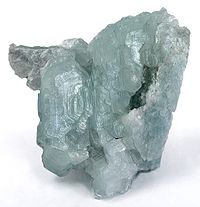Brucite

Brucite is a mineral that has a special name because it's a type of rock that is very different from other rocks like granite or marble. Imagine if you had a rock that looked like a small piece of chalk or a smooth, white pebble. That rock would be brucite! It's made up of a special kind of molecule called magnesium hydroxide and it's found in lots of different places all around the world.
One cool thing about brucite is that it can be transformed into other minerals when it's exposed to certain types of heat or pressure. For example, if you put brucite under a lot of pressure for a very long time, it can turn into a type of rock called serpentine. This is the same process that happens deep inside the Earth's crust to create things like diamonds or certain types of precious stones.
Brucite is also used by scientists to study what happens inside the Earth's mantle. The mantle is the layer of the Earth that's under the crust and it's much hotter and pressurized than the surface. Brucite is one of the few minerals that can survive these extreme conditions and can be used to understand the composition of the mantle and how it affects the movement of tectonic plates, which are the pieces of the Earth's crust that move around and sometimes cause earthquakes.
In summary, brucite is a mineral that is special because of its chemical composition and its ability to transform into other minerals. It's also used by scientists to study the Earth's mantle and tectonic activity.
One cool thing about brucite is that it can be transformed into other minerals when it's exposed to certain types of heat or pressure. For example, if you put brucite under a lot of pressure for a very long time, it can turn into a type of rock called serpentine. This is the same process that happens deep inside the Earth's crust to create things like diamonds or certain types of precious stones.
Brucite is also used by scientists to study what happens inside the Earth's mantle. The mantle is the layer of the Earth that's under the crust and it's much hotter and pressurized than the surface. Brucite is one of the few minerals that can survive these extreme conditions and can be used to understand the composition of the mantle and how it affects the movement of tectonic plates, which are the pieces of the Earth's crust that move around and sometimes cause earthquakes.
In summary, brucite is a mineral that is special because of its chemical composition and its ability to transform into other minerals. It's also used by scientists to study the Earth's mantle and tectonic activity.
Related topics others have asked about:
